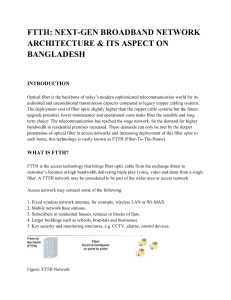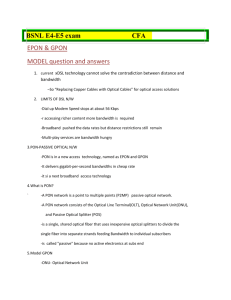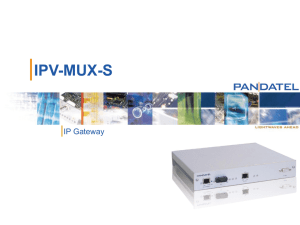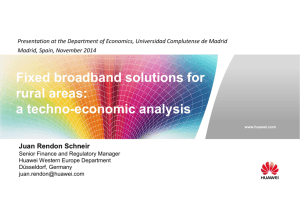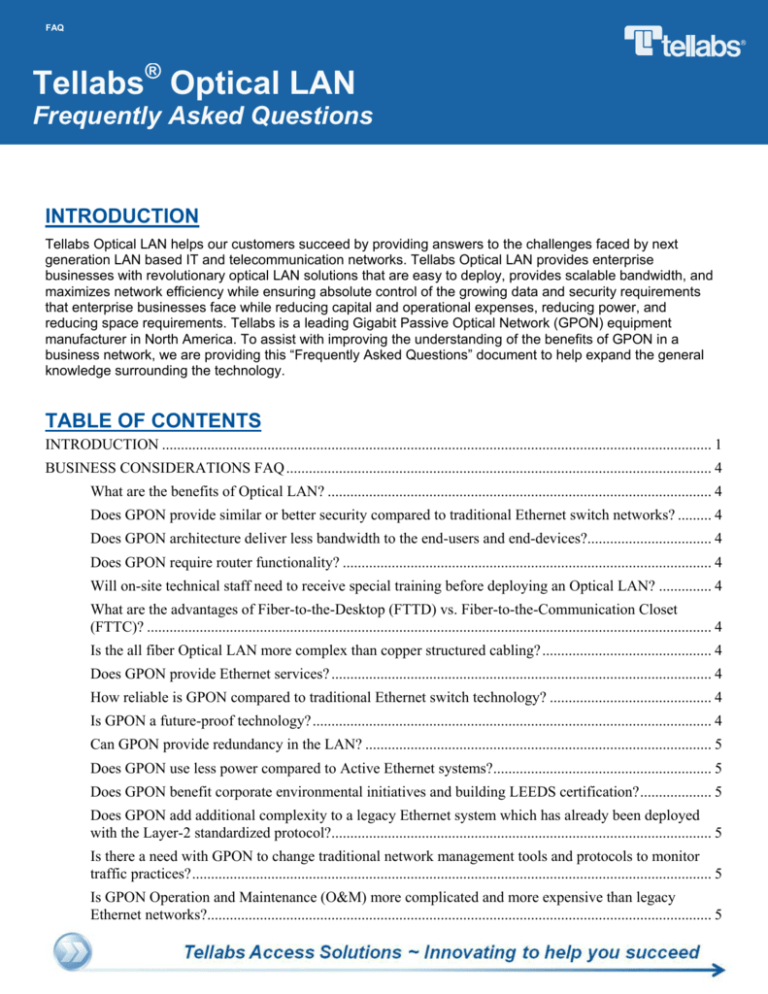
FAQ
Tellabs® Optical LAN
Frequently Asked Questions
INTRODUCTION
Tellabs Optical LAN helps our customers succeed by providing answers to the challenges faced by next
generation LAN based IT and telecommunication networks. Tellabs Optical LAN provides enterprise
businesses with revolutionary optical LAN solutions that are easy to deploy, provides scalable bandwidth, and
maximizes network efficiency while ensuring absolute control of the growing data and security requirements
that enterprise businesses face while reducing capital and operational expenses, reducing power, and
reducing space requirements. Tellabs is a leading Gigabit Passive Optical Network (GPON) equipment
manufacturer in North America. To assist with improving the understanding of the benefits of GPON in a
business network, we are providing this “Frequently Asked Questions” document to help expand the general
knowledge surrounding the technology.
TABLE OF CONTENTS
INTRODUCTION .................................................................................................................................................. 1
BUSINESS CONSIDERATIONS FAQ ................................................................................................................. 4
What are the benefits of Optical LAN? ...................................................................................................... 4
Does GPON provide similar or better security compared to traditional Ethernet switch networks? ......... 4
Does GPON architecture deliver less bandwidth to the end-users and end-devices?................................. 4
Does GPON require router functionality? .................................................................................................. 4
Will on-site technical staff need to receive special training before deploying an Optical LAN? .............. 4
What are the advantages of Fiber-to-the-Desktop (FTTD) vs. Fiber-to-the-Communication Closet
(FTTC)? ...................................................................................................................................................... 4
Is the all fiber Optical LAN more complex than copper structured cabling? ............................................. 4
Does GPON provide Ethernet services? ..................................................................................................... 4
How reliable is GPON compared to traditional Ethernet switch technology? ........................................... 4
Is GPON a future-proof technology? .......................................................................................................... 4
Can GPON provide redundancy in the LAN? ............................................................................................ 5
Does GPON use less power compared to Active Ethernet systems?.......................................................... 5
Does GPON benefit corporate environmental initiatives and building LEEDS certification? ................... 5
Does GPON add additional complexity to a legacy Ethernet system which has already been deployed
with the Layer-2 standardized protocol?..................................................................................................... 5
Is there a need with GPON to change traditional network management tools and protocols to monitor
traffic practices? .......................................................................................................................................... 5
Is GPON Operation and Maintenance (O&M) more complicated and more expensive than legacy
Ethernet networks?...................................................................................................................................... 5
FAQ
Is battery backup available for GPON networks?....................................................................................... 5
Are UPS units needed at every desktop that requires Power over Ethernet (PoE)? ................................... 5
Does GPON support PoE? .......................................................................................................................... 5
Do you need to change out splitters to add users? ...................................................................................... 6
Is GPON really saving energy if you move the electronics into the workspace? ....................................... 6
Are fiber networks more fragile? ................................................................................................................ 6
Is it difficult to expand a GPON network? ................................................................................................. 6
Do GPON electrical power savings include the power required for the ONTs? ........................................ 6
Is it possible for any GPON user to utilize whatever bandwidth is needed at any time? ........................... 6
Do fiber networks require more or specialized labor to install than legacy active Ethernet cabling? ........ 6
Will a forklift upgrade be required when upgrading to the next generation of 10/2.5 Gbps GPON? ........ 6
Does the Optical LAN support a virtual desktop environment? ................................................................. 6
Does GPON support separate VLANs for VoIP and Data traffic? ............................................................. 6
Does the GPON infrastructure increase power requirements and consumption at the desk? ..................... 7
Does GPON require a modular cable system that is proprietary and untenable in current design/build
models? ....................................................................................................................................................... 7
Does GPON require additional special skills for fiber handling and troubleshooting? .............................. 7
Will installing GPON require that the network administrator support multiple systems in the wiring
closets and data center network distribution areas? .................................................................................... 7
Are fiber networks dangerous to operate? .................................................................................................. 7
Can deployed GPON be replaced in a building without major impact? ..................................................... 7
Does GPON support IP Voice?................................................................................................................... 7
Can analog voice hand-sets be deployed along with VoIP hand-sets with PON? ...................................... 7
Does your Voice Gateway support Fax Machines? .................................................................................... 7
TECHNOLOGY FAQ ............................................................................................................................................ 8
What is Optical LAN? ................................................................................................................................ 8
What is GPON?........................................................................................................................................... 8
How does GPON carry bandwidth on the fiber? ........................................................................................ 8
What is Ethernet Passive Optical Network (EPON) and how does it compare to GPON? ........................ 8
What are the components of Optical LAN? ................................................................................................ 8
How much bandwidth can GPON deliver to an end user? ......................................................................... 8
GPON capacity is 2.5 Gbps shared downstream to 32 ONTs. Is it possible to deliver 1000 .................... 8
Does GPON support power users? ............................................................................................................. 8
Does GPON support bursts of traffic? ........................................................................................................ 8
Does GPON support Port Security?............................................................................................................ 8
What is the Optical Distribution Network (ODN)? .................................................................................... 9
FAQ
Is a point-to-point ODN network (home-run cable plant) more future proof than a legacy Active
Ethernet network? ....................................................................................................................................... 9
Since GPON is a shared medium, is it less secure when compared to Active Ethernet? ........................... 9
Does GPON broadcast data traffic to multiple users on the same fiber?.................................................... 9
Is upstream bandwidth shared in a way that limits bandwidth availability? .............................................. 9
Does GPON provide Quality of Service? ................................................................................................... 9
Does GPON handle video traffic? .............................................................................................................. 9
Does GPON provide Operations, Administration, Maintenance and Provisioning (OAM&P)? ............... 9
Since GPON was developed for the carrier space first, is it suited for enterprises?................................... 9
Does GPON lack redundancy and always have a single point of failure?.................................................. 9
Does GPON support IPv6? ......................................................................................................................... 9
Does installing a GPON solution limit me to only one vendor?............................................................... 10
Does GPON only operate over Single Mode Fiber (SMF)? ..................................................................... 10
Are GPON vendors interoperable? ........................................................................................................... 10
Will additional fiber be required between the Core and Distribution layers of the network? .................. 10
TELLABS OPTICAL LAN EQUIPMENT FAQ ................................................................................................. 10
What is an Optical Network Terminal (ONT)? ........................................................................................ 10
What is an Optical Line Terminal (OLT)? ............................................................................................... 10
Concerning trouble isolation and troubleshooting, how does GPON manage 32 ONTs on a single PON?
................................................................................................................................................................... 10
How do physical plant records for GPON compare to Active Ethernet point-to-point? .......................... 11
Can the Tellabs 1150/1134 deliver Active Ethernet for business services or mobile backhaul? ............. 11
Are there plans to extend the PON fiber to the ONT from 20km to 30km? ............................................. 11
What training is necessary for my staff?................................................................................................... 11
Where are the training classes held, and how long do they last? .............................................................. 11
How are maintenance, provisioning, alarm provisioning and software upgrades handled? . ................... 11
JOINT INTEROPERABILITY TEST COMMAND (JITC) ................................................................................ 11
Does GPON support IPv6? ....................................................................................................................... 11
Is GPON capable of supporting classified traffic? ................................................................................... 12
Was Tellabs the first GPON vendor to successfully complete JITC testing? ......................................... 12
What components and architectures are supported? . ............................................................................... 12
SUMMARY .......................................................................................................................................................... 12
FAQ
BUSINESS CONSIDERATIONS FAQ
What are the benefits of Optical LAN?
Optical LAN takes advantage of GPON technology delivering up to 70% CapEx savings, 80% space savings,
and 90% power savings.
Does GPON provide similar or better security compared to traditional Ethernet switch networks?
Yes. GPON has better security since it implements similar security architecture as layer 2 Ethernet switch
solutions and then adds additional security mechanisms by means of an all fiber network and the GPON
protocol layer.
Does GPON architecture deliver less bandwidth to the end-users and end-devices?
No. When compared to traditional Ethernet switches GPON provides equivalent bandwidth at the network
uplink interface, across transmission equipment switch fabric, and at service module interfaces.
Does GPON require router functionality?
No. Tellabs Optical LAN solution does not require an external router to provide Enterprise services. With
integrated Ethernet bridging, all user-to-user communications can be handled within the OLT/ONT using IEEE
standard protocols. The only time a router would be required is for traffic leaving the local network segment.
Will on-site technical staff need to receive special training before deploying an Optical LAN?
No. The Ethernet end-points do not change, neither do the IP/Ethernet services being delivered. The same
industry training required to support the fiber plant within an active Ethernet LAN is the same industry training
required to support the fiber cable plant within a GPON network. Plus, GPON full feature EMS reduces
physical actions at network aggregation and network access points as well.
What are the advantages of Fiber-to-the-Desktop (FTTD) vs. Fiber-to-the-Communication Closet
(FTTC)?
FTTD leverages the speed and future-proof nature of single mode fiber all the way to the end user
environment. FTTC leverages existing Cat5e/6 horizontal infrastructure while pushing the benefits of GPON
deeper into the LAN.
Is the all fiber Optical LAN more complex than copper structured cabling?
No. PON simplifies the Optical Distribution Network (ODN) design by eliminating the Ethernet distance
restrictions and equipment hierarchy that plagues traditional Enterprise LANs. In fact, PON ODN using (Single
Mode Fiber) SMF reduces space requirements by 90% by converging network service to a single smaller
medium that supports higher density of users. As an additional consideration, the cost of copper cabling is at
an all time high. In a pre-terminated fiber environment, the requirement to terminate cabling is eliminated.
Does GPON provide Ethernet services?
Yes. End-to-end GPON provides IEEE 802.3 standards based Ethernet interfaces for both the network core,
aggregation and the user interfaces.
How reliable is GPON compared to traditional Ethernet switch technology?
GPON equipment meets strict 99.999% availability standards while traditional Ethernet switching
manufacturers advertise a 99.961 availability (more than 3 hours of network down time annually).
Is GPON a future-proof technology?
Yes. A PON ODN utilizing SMF is the closest future-proof LAN infrastructure possible today. Comparing CATx
cabling limitations to SMF superiority relative to bandwidth capacity, distance, pliability, connector and weight
direct comparison. Finally, GPON offers the most graceful future migration to 10GbE and WDM technologies.
FAQ
Can GPON provide redundancy in the LAN?
Yes. GPON can provide redundancy at multiple network uplink interfaces, at the GPON OLT Ethernet switch
module, at the OLT power module, at the ODN before splitter, at the ODN after the splitter, at the GPON ONTs
and at the Ethernet switch subtended from ONTs.
Does GPON use less power compared to Active Ethernet systems?
Yes. Comprehensive energy efficiency studies have shown that an Optical LAN network consumes up to 80%
lower power consumption compared to Active Ethernet networks. In general, Active Ethernet users command
8W to 12W per user port power utilization, where GPON users range from 1.5W to 4W power consumption.
Does GPON benefit corporate environmental initiatives and building LEEDS certification?
Yes. The inherent benefits of PON result in up to 80% lower power consumption and 90% less space. Lower
power consumption has a significant rippling affect across power generation and cooling equipment. Less
space directly results in less equipment being managed from cradle-to-grave and fewer combustibles. All of
these points directly impact environmental initiatives and building LEEDS certification.
Does GPON add additional complexity to a legacy Ethernet system which has already been deployed
with the Layer-2 standardized protocol?
No. When provisioning GPON end points (i.e. network uplinks and ONT interfaces), the traffic is managed at
the Layer-2 Ethernet level. Ethernet centric protocols are utilized for setting traffic management parameters.
Is there a need with GPON to change traditional network management tools and protocols to monitor
traffic practices?
No. GPON Element Management Systems use standard protocols such as RMON and SNMP to support
secure Ethernet deployments and 802.1x for port access control. Support for Bridge MIB enables learning
MAC addresses that are in use. Flow Mirroring is also supported as a powerful tool to monitor select traffic on
the PON.
Is GPON Operation and Maintenance (O&M) more complicated and more expensive than legacy
Ethernet networks?
No. GPON was specifically designed for efficient troubleshooting. O&M is centrally managed with the
management system providing full network visibility. Central management minimizes required field technician
expertise and supports high volume Moves, Adds and Changes (MAC) work for large user communities. The
GPON training and certification program requires much less time and expense than active Ethernet vendor
certifications.
Is battery backup available for GPON networks?
Yes. Nearly all GPON vendors provide battery backup solutions. Tellabs provides several battery backup
solutions that include DC power feeds from the closet to the ONT in the same cable bundle and at the desktop.
The Tellabs MDU utilizes the same power connectivity in the closet as legacy Ethernet devices.
Are UPS units needed at every desktop that requires Power over Ethernet (PoE)?
No. PoE is available on the Tellabs MDU units, which are typically installed in the telecommunications closet
and the UPS requirements for the MDUs installed in the closet are lower than for active Ethernet switches. The
desktop ONTs may either be powered by UPS at the desktop or you may also remotely power the ONTs.
Does GPON support PoE?
Yes. GPON ONTs are available with PoE, both in low power IEEE 802.3af and high power IEEE 802.3at
standard configurations on all ports of the ONTs. The Tellabs solution provides for a centralized DC power
system to manage the PoE power and UPS/backup power for these devices. A desktop solution is also
available as determined by user requirements. Additionally, Tellabs offers POTS ports on the ONTs, which
provides a SIP connection to the network allowing the customer to re-utilize existing analog handsets.
FAQ
Do you need to change out splitters to add users?
No. Adding users is as simple as adding a patch cord to an existing ONT port or an additional fiber to an
available port on the splitter. The splitter extends the network into the work space supporting up to 128 users
on a single fiber. This differs from Active Ethernet, which requires a separate cable run for each user port
which would require 128 individual cable runs to provide the same number of ports as a single fiber.
Is GPON really saving energy if you move the electronics into the workspace?
Yes. The aggregate power consumption is significantly less, as are the HVAC demands. The higher capacity of
optical fibers and the increased 20Km distance eliminates an entire layer of the LAN. For example a 3,000 user
building that would require 40 workgroup switches to provide 99.999% availability can be serviced with only
one GPON OLT.
Are fiber networks more fragile?
No. Fiber cable is now available with a Kevlar wrapping that provides stronger tensile strength and greater
crush resistance than Cat 6a cable. Additionally, Kevlar coated fiber has a much smaller bend radius (less
than 5mm) than Cat 5 (greater than 20mm), 5e, 6 and 6a (greater than 24mm).
Is it difficult to expand a GPON network?
No. Expansion of the GPON network may be established in either of 2 ways: 1) Adding an ONT to an existing
splitter, or 2) Adding a GPON link into the end user environment. The Tellabs 1150, OLT, is a high density
chassis that is capable of supporting up to 8192 user ports, which is much denser than any active Ethernet
switch. Additionally, the GPON optics allows the ONT to be placed as far away as 30km from the OLT.
Do GPON electrical power savings include the power required for the ONTs?
Yes. The Tellabs business cases include the power requirements for the OLTs, ONTs and all associated
power supplies.
Is it possible for any GPON user to utilize whatever bandwidth is needed at any time?
Yes. One of the major advantages that GPON has over legacy active Ethernet is the ability to easily control
bandwidth for every user port. Provisioning bandwidth provides the ability to establish Service Level
Agreements (SLAs) that guarantee bandwidth as required for each port and user. If desired, every user can be
guaranteed a minimum amount of bandwidth and bursting rates up to 1Gps.
Do fiber networks require more or specialized labor to install than legacy active Ethernet cabling?
No. Fiber is now available pre-connectorized and if you wish to cut the fibers to custom lengths, new
technology requires only seconds to install a connector. Modern fiber runs can be pulled in the same manner
as typical copper Ethernet cables.
Will a forklift upgrade be required when upgrading to the next generation of 10/2.5 Gbps GPON?
No. This will ultimately be managed at the port level with simultaneous support for both 10GbE and 2.4GbE
GPON. 10GbE GPON will require new OLT PON modules and new ONTs, before services can be rolled over
on to existing ODN splitters on a per port basis. The ODN stays the same and there will be no wavelength
conflict, thus allowing 10GbE and 2.4GbE GPON to co-exist on the same ODN.
Does the Optical LAN support a virtual desktop environment?
Yes. The GPON/Optical LAN is a layer 2 transport schema which is agnostic towards all network traffic. In
fact, virtual desktops consume far less bandwidth than a traditional desktop deployment and is therefore more
efficient.
Does GPON support separate VLANs for VoIP and Data traffic?
Yes. Each individual port on the Tellabs GPON ONT is capable of supporting up to 8 different VLANS
including a mixture of tagged and untagged VLANs. This capability provides up to 32 different VLANs on a
single 4 port ONT. Quality of Service is configurable for Class of Service, Layer 2, 3 and 4 ACLs, and DSCP
classification for packet prioritization of VoIP traffic.
FAQ
Does the GPON infrastructure increase power requirements and consumption at the desk?
No. While some of the power consumption is moved from the closet to the desk, the actual power
consumption per port of a GPON solution including all OLTs and ONTs with full IEEE 802.3 at 30W power
output and a centralized DC power source consumes between 70% and 90% less electricity than a traditional
active Ethernet solution. Additionally, the latest ONT offerings allow the ONT to be powered from a central
“zone” type enclosure.
Does GPON require a modular cable system that is proprietary and untenable in current design/build
models?
No. Fiber optic cabling systems are offered by a variety of well established infrastructure manufacturers such
as Corning, 3M, ADC and CommScope. The fiber performance characteristics are based on fiber industry
standards. Planning for the fiber optic inside plant does not require weight calculations for cable tray design
and building structural consideration.
Does GPON require additional special skills for fiber handling and troubleshooting?
No. The same industry training required to support the fiber plant within an active Ethernet LAN is the same
industry training required to support the fiber cable plant within a GPON network. Fiber has actually become
easier to work with over the last few years. In fact, fiber is now bend-insensitive with high tensile strength.
Crush resistant and pre-terminated fiber is also available. It should also be noted that the excessive weight of
copper cabling requires additional logistical and handling considerations over fiber.
Will installing GPON require that the network administrator support multiple systems in the wiring
closets and data center network distribution areas?
No. A fully integrated GPON network actually reduces the number of disjointed network management systems
within a data center or wiring closet. GPON provides convergence of voice, data, IP and RF Video, POTS,
security, surveillance, VTC, alarms, environmental systems and access control systems over a single network
utilizing the advanced security features of QoS, class of service and VLAN mechanisms.
Are fiber networks dangerous to operate?
No. GPON fiber optics are just as safe as Ethernet networks that utilize lasers. It should be noted that the
lasers used are Class B+ lasers. Anytime someone works with laser optic devices, care should be taken. The
SFPs used in active Ethernet have the same safety precautions as those used with GPON devices.
Can deployed GPON be replaced in a building without major impact?
Yes. The ability to add users is greatly enhanced over active Ethernet as the cable plant is now run directly to
the splitter which can be located in a zone enclosure. Additional users may be added by simply connecting
additional ONTs until the splitter is full. If additional PON connections are required they may be connected to
existing PON ports in the OLT or new cards may be added without existing user impact. Pre-terminated
assemblies allow for lower skilled technicians to install the system and add new users much faster than that of
a legacy Ethernet network.
Does GPON support IP Voice?
Yes. GPON treats VoIP traffic as a separate IP flow, guaranteeing bandwidth delivery and ensuring proper
authentication and security mechanisms.
Can analog voice hand-sets be deployed along with VoIP hand-sets with PON?
Yes. GPON can support both analog voice and IP voice services. This benefit results in significant savings for
those customers that want to continue to leverage their analog voice hand-sets.
Does your Voice Gateway support Fax Machines?
Yes. The Tellabs 1000 Voice Gateway, when paired with Tellabs Optical LAN solution, provides fax services
to end user locations via analog POTS interface or VoIP over Ethernet interface. The ONT provides the SIP
ATA function in the case of analog POTS, resulting in a true VoIP/SIP LAN environment. The ONT supports
T.38 for fax transmission.
FAQ
TECHNOLOGY FAQ
What is Optical LAN?
Tellabs Optical LAN is a next generation Local Area Network (LAN) solution that leverages the benefits of
single mode fiber to deliver converged data, voice, and video services to enterprise users. The core of Tellabs
Optical LAN is based on GPON technology, a proven and widely deployed access standard.
What is GPON?
GPON stands for Gigabit Passive Optical Network. GPON is a standards based technology through the ITU-T
standards body (ITU-T G.984). The GPON standard specifies 2.5 Gbps in the downlink and 1.25 Gbps in the
uplink. A passive optical distribution network connects the OLT to the ONT using single mode fiber and
splitters, eliminating active electronics in the aggregation and access portions of the network.
How does GPON carry bandwidth on the fiber?
The GPON standard specified multiple wavelengths on each single mode fiber (WDM) to carry downstream
and upstream data, along with optional wavelengths for carrying RF video.
What is Ethernet Passive Optical Network (EPON) and how does it compare to GPON?
Ethernet PON is an access standard similar to GPON, but is based on different protocols and standardized in
different standards bodies (IEEE 802.1ah). EPON also utilizes single mode fiber and passive splitters to
connect OLT and ONT electronics, but suffers from reduced performance, security, and efficiency. GPON is
the preferred technology for Optical LAN solutions.
What are the components of Optical LAN?
An Optical LAN network is very straightforward and easy to design / implement due to limited electronics. The
Optical Line Terminal (OLT) is the aggregation device, while the Optical Network Terminal (ONT) is the end
user device providing standard copper interfaces to client devices.
How much bandwidth can GPON deliver to an end user?
End users are typically delivered Gigabit Ethernet speeds, limited only by the physical Gigabit Ethernet
interface on the ONT.
GPON capacity is 2.5 Gbps shared downstream to 32 ONTs. Is it possible to deliver 1000 Mbps per
user?
Yes. GPON provides a powerful and straightforward approach to designing proper traffic management up to
Gigabit Ethernet speeds to each end user. Each ONT fully supports the IEEE 802.3 Ethernet interface
standards.
Does GPON support power users?
Yes. GPON delivers 2.5 Gbps of bandwidth to each ONT, so a “power user’s” Service Level Agreement (SLA)
can be configured so the user can take full advantage of the 10/100/1000 Mbps Ethernet interface capacity.
Does GPON support bursts of traffic?
Yes. The user’s service level agreement can be configured with both committed (CIR) and burst (EIR) traffic
parameters, thus supporting guaranteed bandwidth delivery and also supporting intermittent burst traffic
demands.
Does GPON support Port Security?
Yes. The Tellabs Optical LAN supports advanced security mechanisms including per-port, per-service VLANS,
Layers 2/3/4 Access Control Lists (ACL) and 802.1x port-based Network Access Control (NAC).
FAQ
What is the Optical Distribution Network (ODN)?
The ODN includes the passive components such as fiber, fiber management, optical splitters and enclosures
that connect the OLT with the ONTs.
Is a point-to-point ODN network (home-run cable plant) more future proof than a legacy Active Ethernet
network?
Yes. A GPON ODN network may be designed with splitters located at the data center or in the communication
closet, thus the fiber can be home-run all the way to the end user.
Since GPON is a shared medium, is it less secure when compared to Active Ethernet?
No. GPON provides more secure functionality compared to active Ethernet. In fact, an Ethernet switch is also
a shared medium. GPON utilizes advanced security mechanisms, such as AES-128 encryption, to ensure
secure delivery of end user information. The United States Department of Defense has successfully tested
and certified Tellabs Optical LAN solution for use on both secure and non-secure government networks.
Does GPON broadcast data traffic to multiple users on the same fiber?
No. GPON distributes all downlink traffic through secure, virtual point-to-point connections. These point-topoint connections utilize AES-128 encryption between the OLT and ONT.
Is upstream bandwidth shared in a way that limits bandwidth availability?
No. GPON enforces both committed (CIR) and burst (EIR) data delivery on a per-port, per-service. Dynamic
Bandwidth Allocation (DBA) in the upstream path ensures the service level agreements are enforced.
Does GPON provide Quality of Service?
Yes. Quality of Service is guaranteed on a per-port, per-service basis for each end user. Service provisioning
supports both Committed Information Rate (CIR) and Excess Information Rate (EIR) to deliver guaranteed and
support burst data delivery. Compared to active Ethernet, GPON offers a higher level of QoS that is easier to
provision and maintain.
Does GPON handle video traffic?
Yes. GPON provides both RF video and Internet Protocol TV (IPTV) support. RF video is carried on separate
wavelengths on the GPON fiber. For IPTV, IPTV channels are efficiently multicast across the GPON
infrastructure using IGMPv2 and IGMPv3 protocols.
Does GPON provide Operations, Administration, Maintenance and Provisioning (OAM&P)?
Yes. The Tellabs GPON solution has embedded OAM between the OLT and ONT, which is accomplished by
the ONT Management & Control Interface (OMCI) managing the end services. OMCI provides configurations,
fault, performance and security management functionality. OMCI functionality of the Tellabs® PanoramaTM
Integrated Network Manager (INM) provides a user-friendly graphical user interface for OAM&P tasks.
Since GPON was developed for the carrier space first, is it suited for enterprises?
Yes. Carrier-class standards require a minimum 99.999% availability which is far greater than typical
enterprise standards of only 99.9%. Tellabs Optical LAN integrates enterprise data networking capability into a
highly available GPON solution resulting in the best of both worlds.
Does GPON lack redundancy and always have a single point of failure?
No. Tellabs Optical LAN offers multiple design options that provide redundancy at every level of the network,
including the PON link, ONT, module and system redundancy. Due to the carrier class 99.999% availability,
redundancy may not be required in all areas of the network, greatly reducing the cost of deployment. The
higher availability of a GPON network provides True Carrier Grade Reliability to the Enterprise.
Does GPON support IPv6?
Yes. The Tellabs Optical LAN solution supports IPv6 today and is certified by the US Department of Defense.
FAQ
Does installing a GPON solution limit me to only one vendor?
No. Although Tellabs is the leader in Optical LAN technology, several other vendors offer enterprise solutions
using GPON technology.
Does GPON only operate over Single Mode Fiber (SMF)?
Yes. GPON only operates over single mode fiber, which results in many benefits compared to multimode fiber
including: Much greater distance (30km vs. 550m), significantly higher bandwidth capability (69 Tbps), and
reduced fiber count. Single mode fiber is near future-proof with a life expectancy of 30+ years.
Are GPON vendors interoperable?
Yes. GPON solutions from different manufacturers can operate on the same enterprise network. The OLT
interfaces are based on 802.3 Ethernet standards, allowing different GPON solutions to be deployed in
different areas of a building or campus. This is similar to active Ethernet solutions today. It should be noted
that the OLT to ONT connection is vendor specific and the interoperability is only on the uplink from the OLT.
Will additional fiber be required between the Core and Distribution layers of the network?
No. A typical GPON solution requires half of the fiber count between the Core and Distribution layers of the
network compared to an active Ethernet backbone. GPON utilizes bi-directional single mode fiber, which
removes the multimode network requirement for two fibers per interface (tx and rx).
TELLABS OPTICAL LAN EQUIPMENT FAQ
What is an Optical Network Terminal (ONT)?
An ONT is a media converter that is the end termination device for a GPON system and is located at the
ultimate premises receiving services. The ONT converts fiber-optic light signals to the standard IEEE 802.3
Ethernet copper/electric signals. Four wavelengths of light are used between the ONT and the Optical Line
Terminal (OLT) are 1310 nm voice/data transmit, 1490 nm voice/data receive, 1550 nm video receive and
1590 nm for video return path.
What is an Optical Line Terminal (OLT)?
OLTs are the GPON equipment that is typically placed at the network core or Central Office. This equipment
serves as the point of origination for Fiber-to-the-Premises (FTTP) transmissions. An OLT, in a nutshell, is
where the PON interface cards reside and where network uplinks connect to voice, data and video services.
Each PON card transmits 1490nm laser data signal to the ONT and receives the ONT transmission of the
1310nm laser data signal. Additionally, a one-way 1550nm laser RF video signal to the ONT is injected into the
fiber at the CO with up-stream return path at 1590nm for interactive/bi-directional RF video services.
Concerning trouble isolation and troubleshooting, how does GPON manage 32 ONTs on a single PON?
First, through GPON OMCI and Tellabs Panorama INM, superior fault troubleshooting and isolation is
provided. Tellabs Panorama INM starts with a macro topology manager that provides network wide view from
OLT network links down to the ONT individual services being delivered. Panorama provides color coded visual
identification of alarms and their severity. Panorama also stores pertinent network data continuously such as
activities, events, and alarms. This provides an excellent audit trail for quick assessment or root cause
analysis. Panorama INM allows users to drill down at any level for alarm detail. Alarm tracking notes utilizes
filtering and sorting capabilities for all event logs and aging of data. Furthermore, Panorama INM can be
integrated with any customers’ 3rd party fault management systems through standards based north bound
interfaces. Second, there is a public misconception that a single rogue ONT can cause an internal malicious
attack against its 31 other peers. While this was true in the early days of PON development almost 10 years
ago, it was immediately address and corrected.
FAQ
How do physical plant records for GPON compare to Active Ethernet point-to-point?
As stated above, “if” home-run ODN design is desired, then it can be utilized for GPON network as well. Homerun ODN offers higher first cost capital investment but provides lower year-over-year operational expenses (i.e.
no splitters, fiber management nor enclosures in the outside plant). A distributed ODN network offers lower
CapEx due to its efficient use of fibers and effective splitting strategies. Distributed ODN offers a simplified
physical plant to manage with less outside plant fiber in the ground to manage.
Can the Tellabs 1150/1134 deliver Active Ethernet for business services or mobile backhaul?
Yes. Ethernet business services/mobile backhaul can be delivered on the Tellabs 1150/1134 in two different
ways: 1) Idle ESU interfaces can be used with Tellabs 7305 Ethernet Demarcation Device at the customer
premises demarc. 2) Ethernet services can be delivered from ONTs (i.e. 709, 728) and ODN split can be
designed at lower split ratios for appropriate traffic management.
Are there plans to extend the PON fiber to the ONT from 20km to 30km?
Yes. The Tellabs GPON product line supports 30km separation. A physical limitation of Class B+ optics and
ODN split degradation and GPON systems can set logical limits such as 20km to accommodate such signal
losses. Tellabs Optical LAN extends the logical limit to 30km understanding that the ODN split based on -28
dB total loss budget must still be honored. Therefore, conservatively speaking a 30km designed ODN will
support a 1:8 split ratio.
What training is necessary for my staff?
Tellabs provides a 5 day technical hands-on training course that covers turn up, provisioning and maintenance.
Where are the training classes held, and how long do they last?
Training is offered in Tellabs Naperville Headquarter location and the training schedule is posted on Tellabs
Portal.
How are maintenance, provisioning, alarm provisioning and software upgrades handled? Tellabs
Panorama INM provides a central platform to monitor, provision and manage maintenance and system
upgrades without requiring your IT staff to upgrade individual users workstations.
JOINT INTEROPERABILITY TEST COMMAND (JITC)
What is JITC Certification? Joint Interoperability Test Center (JITC) certification is a United States
Department of Defense network certification that is issued upon successful interoperability testing with other
vendors at the JITC testing facility. The DoD testing is designed to assure that all DoD network systems being
fielded are compatible with existing networks. Certification is valid for 3 years and is required for network
equipment to be connected to the Defense Information Systems Network (DISN) and for listing of the
equipment on the Unified Communication Approved Products List. Additional testing is required for any and all
hardware and software revisions completed after the initial testing.
Is the Tellabs GPON solution JITC certified? Yes. The solution is on the current JITC APL. Furthermore,
Tellabs is continuing to schedule JITC testing based on new enhancements to the software and hardware.
Is the Tellabs GPON solution approved for use within an Assured Services LAN? Yes. The Tellabs JITC
certification specifically states that the Tellabs solution is approved for use as a network element within an
Assured Services High Availability LAN.
Does GPON support IPv6?
Yes. The Tellabs solution has been certified at the DoD’s JITC lab running IPv6.
FAQ
Is GPON capable of supporting classified traffic?
Yes. The US Air Force accredited and deployed Secure PON for SIPERNET use. Additionally, two U.S.
government intelligence agencies have deployed GPON systems. The GPON system utilized within a Secure
PON system is certified by the National Security Agency (NSA) and is accredited for multiple classification
levels within the same fiber cable – active Ethernet does not have this accreditation. GPON utilized in
conjunction with Secure PON is more secure than active Ethernet and is installed at a much lower cost than
the standard government Protected Distribution System (PDS).
Was Tellabs the first GPON vendor to successfully complete JITC testing? Yes. Tellabs received its first
JITC certification on February 4, 2010.
What components and architectures are supported? The Tellabs solution includes the 1150 and 1134
MSAPs, and the 704, 709, 709GP, and 729 ONTs. A complete list of approved equipment is available on the
UCR APL.
SUMMARY
At Tellabs we strive to deliver innovative solutions that enable our customers to be successful. We will continue
to lead the industry with advancements in GPON, Ethernet, Optical LAN and WDM-PON. We appreciate our
customers continued consideration and support in delivering a fulfilling experience for the ultimate end user
services through GPON.
For more information, please contact your local Tellabs sales representative, local Tellabs sales office, at the
phone numbers provided below or visit www.tellabs.com.
Europe, Middle East &
Latin America & Caribbean
Africa
Tellabs
Tellabs
1401 N.W. 136th Avenue
Abbey Place
Suite 202
24–28 Easton Street
Sunrise, FL 33323 U.S.A.
High Wycombe, Bucks
+1 954 839 2800
HP11 1NT
Fax: +1 954 839 2828
United Kingdom
+44 870 238 4700
®
The following trademarks and service marks are owned by Tellabs Operations, Inc.,
its affiliates
the United States and/or in other countries: TELLABS ,
Fax:or+44
870 238in4851
North America
Tellabs
One Tellabs Center
1415 West Diehl Road
Naperville, IL 60563 U.S.A.
+1 630 798 8800
Fax: +1 630 798 2000
®
Asia Pacific
Tellabs
3 Anson Road
#14–01 Springleaf Tower
Singapore 079909
Republic of Singapore
+65 6215 6411
Fax: +65 6215 6422
®
TELLABS and T symbol , and T symbol . Statements herein may contain projections or other forward-looking statements regarding future events, products,
features, technology and resulting commercial or technological benefits and advantages. These statements are for discussion purposes only, are subject to
change and are not to be construed as instructions, product specifications, guarantees or warranties. Actual results may differ materially. The information
contained herein is not a commitment, promise or legal obligation to deliver any material, code, feature or functionality. It is intended to outline Tellabs’ general
product direction. The development, release and timing of any material, code, feature or functionality described herein remains at Tellabs’ sole discretion.
© 2011 Tellabs. All rights reserved. 74.XXXXE Rev. A 10/11

